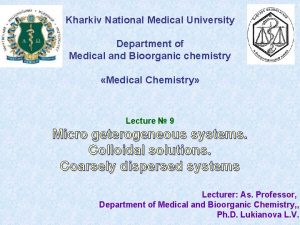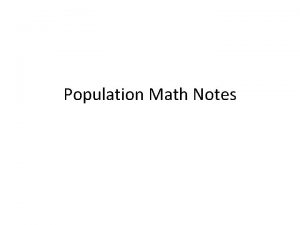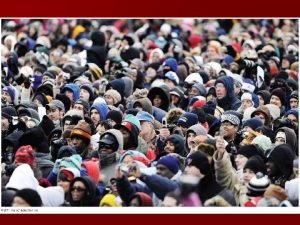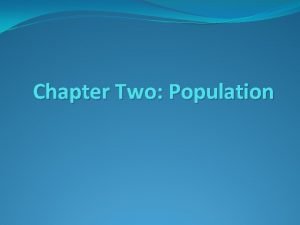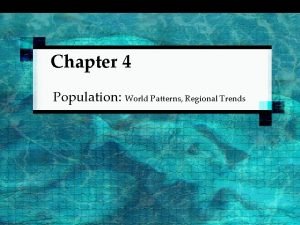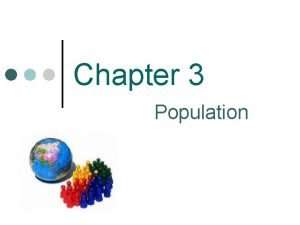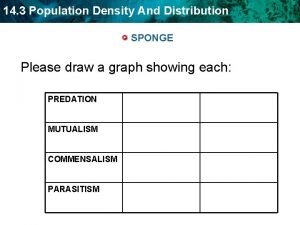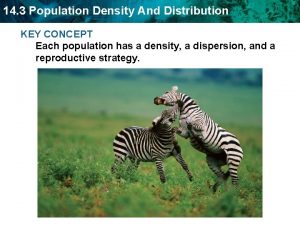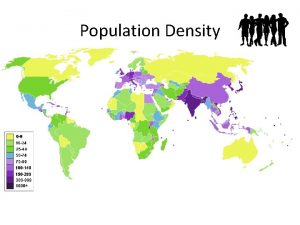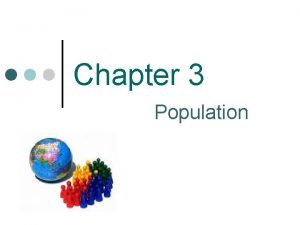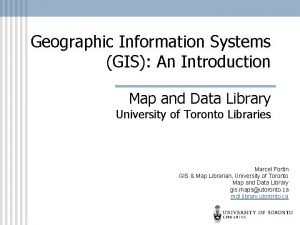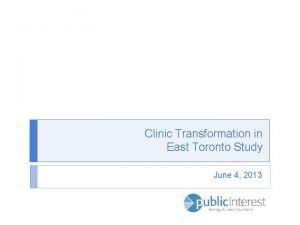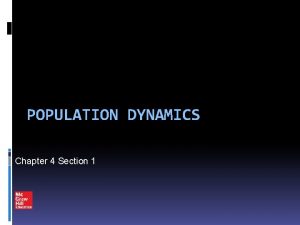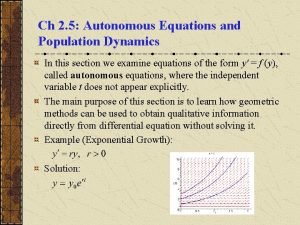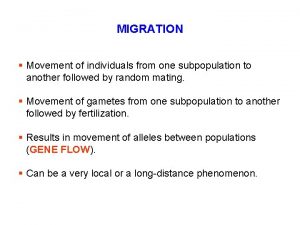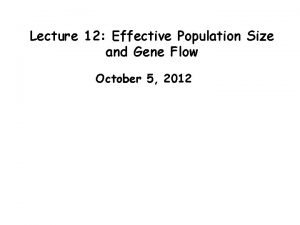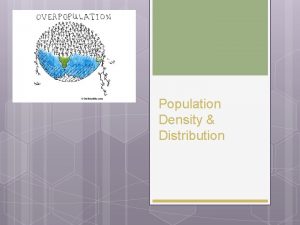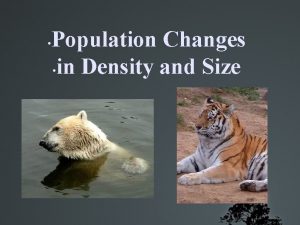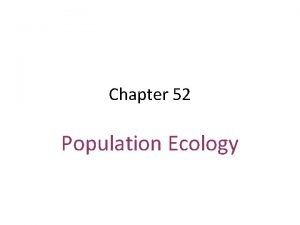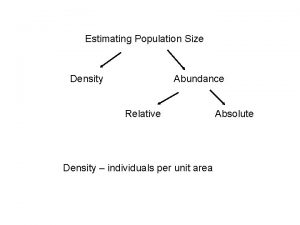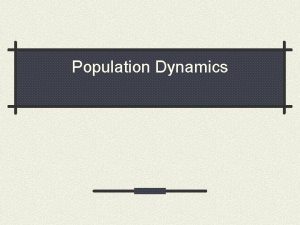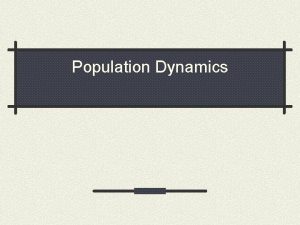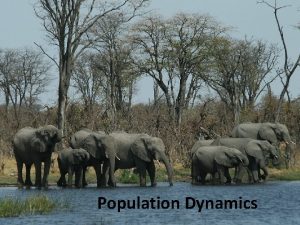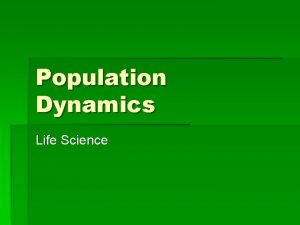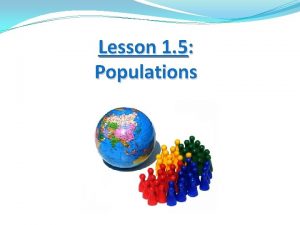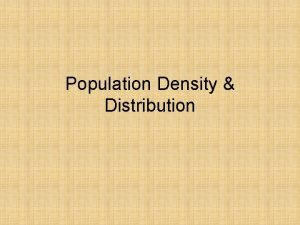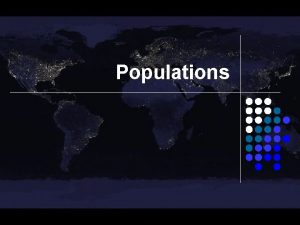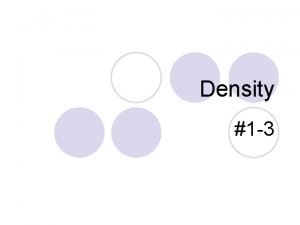Population Dynamics Population change in Size Density Dispersion

























































- Slides: 57

Population Dynamics

• Population change in : – Size – Density – Dispersion – Age distribution • Change due to stress

Population change • Growth sources: – Birth, death, emigration (out), immigration (in) • Depends on resource availability • Density independent controls – anything that reduces size despite population size (natural disasters) • Density dependent controls – reduces size of population but size can influence (disease, predation)

Carrying Capacity • Carrying capacity – max population that a habitat can sustain


Population Growth • Exponential – has few resource limitations • Logistic – slow and steady over time; carrying capacity maintained


Population curves: – Stable – fluctuates right above and below K – Cyclic – rises and falls in regular intervals – Irruptive – increase drastically and quickly (more rare)


Predation and Population Control • Top-down control – Trophic cascade • Bottom-up control –Primary productivity


Opportunist or r-selected species • • • Reproduce early in life Short generation times Have many offspring Short life span Reproduce rapidly when conditions are favorable

Competitor or K-selected species • Reproduce late in life • Have few offspring that are nurtured them to maturity • Do well in competitive conditions

Survivorship Curves

Influences • List at least one thing that comes to mind with the following words? – Religion – Culture – Industrialized Nation – Developing Nation • How would these factors influence the population size of a country?

Survivorship Curves • Shows the number of survivors of each age for a particular species • Three types: – Early loss: typical of r-selected; many die out early in their life (Type III curve) – Constant loss: have fairly constant rate of mortality in all age ranges (Type II curve) – Late loss: typical of K-selected species; lots of energy to assure offspring reach reproductive age (Type I curve)


• The human population is about 7. 35 billion people. In the 1800’s, it finally reached 1 billion. What factors have contributed to this surge in the human population size?

Human Population



CBR and CDR • CBR (crude birth rate) – number of live births per 1000 people • CDR (crude death rate) – number of deaths per 1000 people • Demographers use CBR and CDR to make predictions about potential population size

Fertility Rates – Replacement level fertility – # of children a couple must bear to replace themselves – Total fertility rate – average number of children a woman will have during childbearing years • USA – 2. 06 • India – 2. 58 • China – 1. 55 Italy – 1. 4 Japan – 1. 3

Quality of Life Measure… • Infant mortality rate – Indicates health care capabilities of country

Factors Affecting Birth Rates • Are children important to the labor force? • Cost of raising and educating children • Educational and employment opportunities for women • Infant mortality rate • Availability of reliable methods of birth control • If it is available, will people use it? • Religious beliefs, traditions, and cultural norms

Factors that Affect Death Rate • Reasons for decline: – Increased food supplies – Better nutrition – Improvements in medicine and public health • As these things increase, so does the life expectancy of a society (average # of years a newborn can be expected to live)

Population Age Structure • Histograms show the proportion of the population at each age level • Divided by age and gender – Males – left; females - right • 3 categories: – Prereproductive (0 -14) – Reproductive (15 -44) – Postreproductive (45+)

What A Histogram Can Show You • • Industialization Growth rate War or Disease Baby boom

Type of population growth – Rapid – large section of population is 15 -under • Means lots of young people will move into reproductive age • More common in developing countries •

Rapid Growth

Slow – Zero Growth • Population pretty evenly distributed

Slow-Zero Growth

Negative Growth • Majority of population is in late reproductive to post reproductive age

Negative Growth

Compare the two histograms. Identify the growth rate and predict the population size in 50 years

Demographic Transitions – Moving towards Industry • 4 Stages: – Preindustrial : • Little population growth due to harsh conditions • High birth rates and high death rates (close to ZPG) – ZPG – Population size remains steady, no growing – Transitional: • Industrialization begins, health rises, food rises • High birth rates b/c children aren’t dying out, but death rate drops


– Industrial : • Industrialization is widespread and birth rates begin to drop – Postindustrial: • Reaches ZPG


New th 5 Stage? • Declining – the population will decline due to death rate being higher than birth rate


No Calculator – Calculate the following • 1. 100/12 • 2. 60/2. 5 • 3. 48/3. 2

Calculating % Growth Rate • Formula = CBR-CDR/1000 x 100% OR CBR-CDR/10 • In 2000, the world birth rate was 10 births per 1000 people. The world death rate was 12 deaths per 1000 people. Calculate the world % growth rate

You Do It • In 1900, the world birth rate was 42 births per 1000 people. The world death rate was 36 deaths per 1000 people. Calculate the world growth rate %.

Doubling Time • Amount of time it will take a population to double in size (assuming a constant rate) • Can calculate by growth rate or years • To find years using a rate = 70 / Rate • To find rate using years = 70 / # of years

• Time Example – A population doubles in 10 years. What is the growth rate of this population?

You Do It • It takes a population 140 years to double in size. What is the growth rate of this population?

• Growth Rate Example – A population has a growth rate of 2. 0 in 2000. In what year would the population be double its current value?

You Do It • A population had a growth rate of 3. 5% in 2010. In what year would the population be double its current value?

Calculating Population Growth Over 1 Year • How a population changes over the course of a year including migration • Formula: – PN = PI + [(B-D)(# of thousands)] + [(I – E) (thousands)] • • • PN = Population expected for next year PI = Initial population of area B = birth rate D = death rate I = immigration E = emigration

• A suburb of Charlotte has a population of 5, 000 people in 2000. The birth rate was measured at 25 per 1000 population while the death rate was measured at 18 per 1000 population per year. Immigration was measured at 10 people per 1000 and emigration was measured at 7 people per 1000. Calculate the population size in 2001.

• A suburb of Charlotte has a population of 10, 000 people in 2002. The birth rate was measured at 10 per 1000 population while the death rate was measured at 15 per 1000 population per year. Immigration was measured at 10 people per 1000 and emigration was measured at 15 people per 1000. Calculate the population size in 2003.

Population Control in China and India • China • Considered successful because it is made available to everyone and there are economic incentives • India • Birth control is not equally accessible • Growth rate is declining • High infant mortality and early childhood mortality

Cutting Growth Population Growth • 1994 –Conference on Population and Development - Cairo, Egypt • Goals: – – – Stabilize population @ 7. 8 billion people Provide universal family planning Improve health care Increase access to education Take steps to eradicate poverty

Population Momentum • The natural rate of a country’s population increase

Find the growth rate, the population density, which country will double the fastest, and the population size after one year using the growth rate • Top 10 Most Populous Countries in the World: – China – India – USA – Indonesia – Brazil - Pakistan - Nigeria - Bangladesh - Russia - Japan

After you have calculated all countries… • Pick a country from the list. Summarize the information you found about population size, density, etc. Then, explain why you think this country’s population is the size that it is. Also, discuss at least 2 potential issues that the country should be on the lookout for at the current rate of growth…
 Dispersion phase and dispersion medium
Dispersion phase and dispersion medium Dispersion phase and dispersion medium
Dispersion phase and dispersion medium In which type of fibers intermodel dispersion loss occurs
In which type of fibers intermodel dispersion loss occurs Crude population density vs physiological density
Crude population density vs physiological density Chapter 4 population ecology section 1 population dynamics
Chapter 4 population ecology section 1 population dynamics Population ecology section 1 population dynamics answer key
Population ecology section 1 population dynamics answer key Population ecology section 1 population dynamics
Population ecology section 1 population dynamics Chapter 4 section 1 population dynamics study guide answers
Chapter 4 section 1 population dynamics study guide answers Definition of specific gravity
Definition of specific gravity Planar density fcc 100
Planar density fcc 100 Linear density of atoms
Linear density of atoms High density low density
High density low density What is physiological density ap human geography
What is physiological density ap human geography Tennessee population density map
Tennessee population density map Population density formula
Population density formula Different types of climate
Different types of climate Name something associated with china
Name something associated with china Direction distortion ap human geography definition
Direction distortion ap human geography definition Hackney population density
Hackney population density Physiological density
Physiological density Crude population density
Crude population density Physiological density
Physiological density How to calculate population density
How to calculate population density Random population distribution
Random population distribution How to calculate population density
How to calculate population density Population density example
Population density example Population density example
Population density example Chapter 27 physical geography of east asia
Chapter 27 physical geography of east asia China density of population
China density of population Toronto population density
Toronto population density Toronto population density
Toronto population density Mariana trench
Mariana trench Population density formula
Population density formula Chapter 14 interactions in ecosystems
Chapter 14 interactions in ecosystems Whats a density independent factor
Whats a density independent factor Chapter 4 population ecology answer key
Chapter 4 population ecology answer key Population dynamics
Population dynamics Fish population dynamics and stock assessment
Fish population dynamics and stock assessment Autonomous equations and population dynamics
Autonomous equations and population dynamics Const name void
Const name void Sieving method in pharmacy
Sieving method in pharmacy Effective population size
Effective population size Effective population size
Effective population size Change page size word
Change page size word Change in position or size
Change in position or size Termux chrome
Termux chrome Examples for physical change
Examples for physical change Chemical changes examples
Chemical changes examples Absolute change and relative change formula
Absolute change and relative change formula Integer number definition
Integer number definition Difference between chemical and physical property
Difference between chemical and physical property Change in supply vs change in quantity supplied
Change in supply vs change in quantity supplied Supply and demand curve shifts
Supply and demand curve shifts Change your water change your life
Change your water change your life Proactive and reactive change
Proactive and reactive change Physical vs chemical change examples
Physical vs chemical change examples Spare change physical versus chemical change
Spare change physical versus chemical change Rocks change due to temperature and pressure change
Rocks change due to temperature and pressure change
